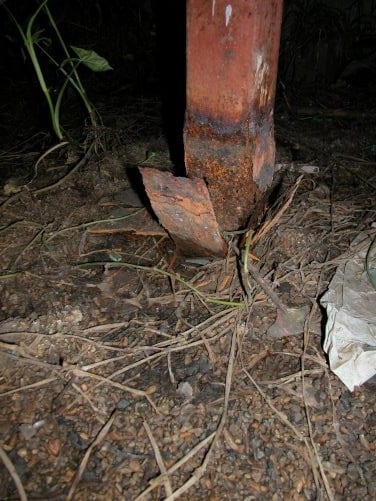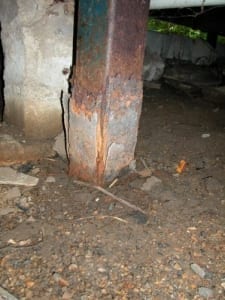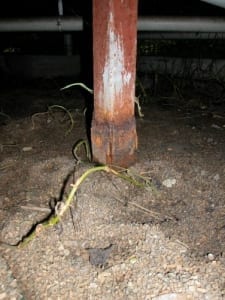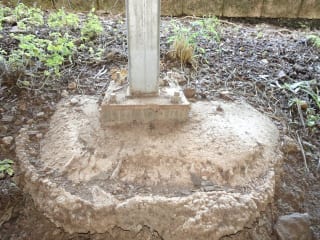Why supports of a building are rusting and what to do to avoid this expensive fault.
The importance of knowing what causes rusting of building supports so you know how to stop its re-occurence. What you must understand about building supports and their footings that are two of the most important structural components in the construction of a building. QBIS.
Rusted building steel column supports and expensive problems they cause
Steel supporting column has rusted way beyond repair, requiring replacing. Its concrete footing may also be fractured from expansion caused by rusting. The footing would need to be checked for fractures and be replaced, if necessary. This procedure can be very costly, especially if access for machinery is not possible.
Significant rusting of columns supporting a house
Ponding of water around base of this steel column has caused significant rust. This could easily have been avoid if correct methods of construction were used when being built. Lack of experience is often why builders cause these faults. These serious problems often occur not long after the builders guarantee period has expired.
Cause of column supports to rust.
- Downpipes not attached to a stormwater system
- Lack of surface drains to the property and around the building.
- Insufficient fall and drains below the building.
- Water ponding around bases of the columns.
Bear in mind that too many drains can cause movement of the building, depending upon the type of soil.
Problems that can occur from by rusting of supporting columns.
- Severe movement of the building.
- Uneven floor.
- Leaning of walls/openings.
- Cracking of floor and wall tiles.
- Damage to plumbing pipes attached to the building.
- Opening up of floor, ceiling and wall linings in traditional Queenslander’s.
- Fracturing of footings supporting columns.
- Fractures to slabs where columns are incorporated within them.
Rectification required of rusting steel building supports.
- Remove entire rusted column.
- Do not cut columns at concrete level, this will cause further rust and fracturing of footing.
- Straighten floor structure.
- Check and replace fractured footings.
- Fit proper drainage.
- Ensure new concrete footing extends above ground level by at least 100mm.
Never fit concrete over rusted columns, this will accelerate rust!
Preferred methods of fitting supporting columns of buildings.
- I would highly recommend creating a concrete platform with its top side being at least 100 mm above the soil level and bolt the columns to the platform.
- Use hot dipped galvanised columns and bolts.
- Fit appropriate drainage
Never incorporate steel columns in the concrete footing or columns within slab edges.
Watch out for the following to avoid rusting of columns:
- Water entry to the sub-floor
- Ponding of water around bases of the columns.
- Accumulation of soil around bases of the columns.
- Nearby leaking plumbing pipes.
- Condensation pipes from air-condition units.
- Overflow from hot water system.
Soil must be kept clear and water must not pond around bases of steel columns.




